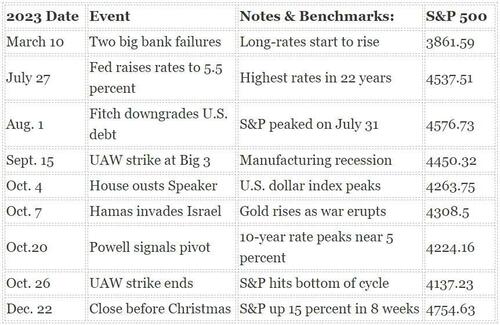Hunter Biden most likely isn’t going to jail any time soon despite an obvious track record of fraud and criminality. But if you happen to be a small business owner in the Land of the Free, you are looking at potentially two years in prison if you don’t comply with new law that just took effect yesterday.
It started nearly five years ago, in the spring of 2019.
Back then, a member of Congress from the state of New York– a career politician with five decades of experience named Carolyn Maloney– introduced a new bill to the House of Representatives called the Corporate Transparency Act, or CTA.
At first her bill didn’t go anywhere.
But the following summer, during the peak Covid insanity of 2020, the CTA was jammed into the nearly 1,500-page National Defense Authorization Act (NDAA), i.e. the military budget that Congress is required to pass each year.
The NDAA (and hence the CTA along with it) were passed on January 1, 2021. And now, three years later, the CTA has formally taken effect.
Now, the whole premise behind the Corporate Transparency Act is the classic boogeyman premise that evil criminals and terrorists use US corporations and LLCs to conduct their illicit activities, so therefore the government wants more rules, regulations, and reporting for US companies.
This is the same simple-minded hysteria that we always hear about cryptocurrency, i.e. criminals and terrorists use Bitcoin, therefore it should be tightly regulated by hapless government bureaucrats.
Obviously, it’s true that criminals can and use crypto– or US business entities like Delaware LLCs– to commit their crimes.
Criminals also use iPhones, Facebook, Gmail, Dell laptops, JP Morgan Chase bank accounts, Ford F-150 pickup trucks, Amazon gift cards, and Verizon Wireless to commit their crimes.
But in this case, in the infinite wisdom of Congress, it’s business entities that are being singled out for additional scrutiny.
So, because criminals sometimes use US business entities to launder money, every law-abiding US citizen with a completely legitimate business now must jump through all sorts of hoops and reporting requirements.
And if you fail to report, you’re looking at two years in prison.
There are so many things about this that are completely stupid.
First off, the United States legal code already has dozens of anti-money laundering laws and regulations on the books. Seriously, dozens.
Yet clearly if Congress saw the need to pass a NEW anti-money laundering law (the CTA), then it stands to reason that those existing laws are ineffective… and hence should be repealed.
But that’s not how the government operates. They don’t strike off ineffective laws. They just keep piling more laws and rules on top of the old ones, creating a mountain of regulation for small businesses to navigate.
And I’m saying “small business” on purpose because that’s who is specifically targeted by the CTA.
Large, publicly traded companies are specifically exempt from reporting under the CTA. So are hedge funds, banks, and other large financial entities. Curiously, tax-exempt charities are also exempt.
So the Corporate Transparency Act deliberately goes after the little guy. Goldman Sachs, Black Lives Matter, and Facebook/Meta are exempt. Bob’s Hot Dog Stand is not.
And this is where it gets really ridiculous. One of the big requirements of the CTA is that small business owners must file a new report to the federal government each year to disclose the company’s shareholders.
But current federal law already requires LLCs to provide this information to the IRS each year. So, the CTA has essentially created a double-burden to send the exact same information– but in a different format– to multiple agencies within the Treasury Department.
You can’t make this stuff up.
And exactly what agency does Bob’s Hot Dog Stand have to report to? It’s called FinCEN, which stands for the Federal Crimes Enforcement Network.
Think about the message they’re sending here; it’s as if owning a business in the United States of America is now some sort of f*ck!ng crime that needs to be reported.
For its part, FinCEN issued nearly ONE HUNDRED PAGES of regulations about how to comply with the CTA. Yes, I’m serious. The Corporate Transparency Act itself was ‘only’ about 20 pages. FinCEN’s rules are five times as long.
And, once again, failure to comply carries steep monetary and criminal penalties, including up to two years in prison.
Even this penalty is idiotic. Think about it– is some guy who launders money for some criminal gang or drug cartel really going to be deterred by the prospect of a two-year prison sentence? Probably not.
It’s far more likely that some completely innocent small business owner has his/her life turned upside down for non-compliance… because, as they always say, “ignorance of the law is not an excuse.”
Look, no one is arguing that criminals don’t often rely on US-registered businesses to conduct illegal activities.
The point is– what is the priority here?
The United States government is in extremely precarious financial condition; calendar year 2023 saw the national debt increase by a whopping $2.5 trillion, totaling roughly $34 trillion as of today.
The debt is so large that annual gross interest payments are about to reach $1 trillion, which takes up a huge chunk of federal tax revenue. And this interest expense keeps growing at an alarming rate.
Forecasts from both the White House and the Congressional Budget Office show that, by 2031, interest expense, along with mandatory entitlement spending like Social Security, will consume the entirety of federal tax revenue.
Everything else we think of as the US federal government– from military spending to non-existent border security– will have to be funded by more debt… which just makes the problem worse.
That fiscal cliff is just seven years away. Then, two years later in 2033, Social Security’s primary trust fund will run out of money and require a multi-trillion-dollar bailout.
The ONLY way out of this mess is to have an economic renaissance in the United States which prioritizes productivity and growth.
It’s simple math; if real (i.e. inflation-adjusted) GDP grows by 3% instead of 2%, all of these problems will melt away over time. The federal government will be swimming in tax revenue, Social Security will be properly funded, and the US could re-assert itself as the global economic leader.
The solution is straightforward, and the US private sector has the capability to do it.
But then the government passes bonehead legislation like this that makes it more difficult, more cumbersome to own a business in America.
Hunter Biden will likely never see the inside of a prison cell. But if you’re one of the millions of small business owners that are critical to US economic growth, you’re now officially at risk if you do not comply.
from Sovereign Man https://ift.tt/zEjyMnI
via IFTTT










